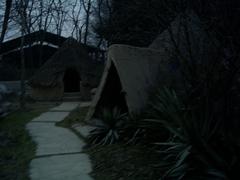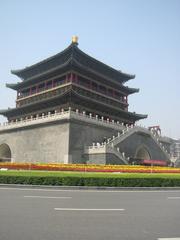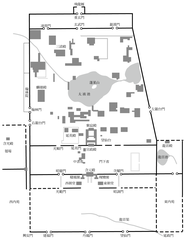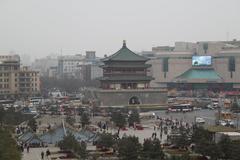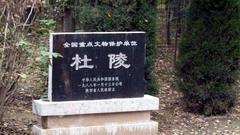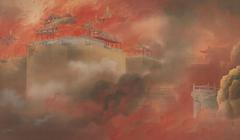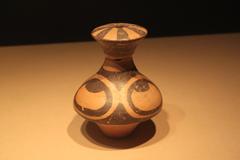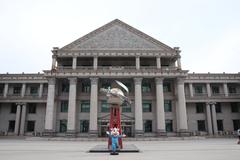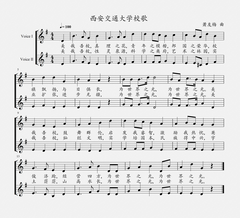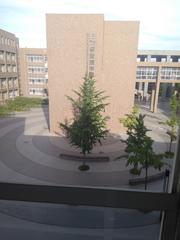Hepingmen Xi’an Visiting Hours, Tickets, and Historical Sites Guide
Date: 04/07/2025
Introduction: Hepingmen and Its Place in Xi’an’s Heritage
Nestled within the ancient city walls of Xi’an, Hepingmen (和平门) — the “Gate of Peace” — stands as an enduring symbol of both historical depth and urban vitality. Xi’an, known in antiquity as Chang’an, is renowned for its more than 3,100 years of history and for serving as the capital of 13 dynasties. Its monumental city wall, constructed primarily during the Ming Dynasty in the 14th century, remains the largest and best-preserved in China, encircling the old city and punctuated by a series of imposing gates (TravelChinaGuide; Global Times).
Hepingmen, a 20th-century addition to this historic fortification, reflects the city’s modern aspirations for peace and progress. Unlike the martial or directional names of older gates, Hepingmen embodies the ideals of harmony, bridging Xi’an’s imperial past with its contemporary dynamism (Ruqin Travel; NewHanfu). Today, visitors can explore not only the architectural grandeur of Ming-era design but also the vibrant street culture, food, and festivals that bring the area to life.
This guide provides a comprehensive overview of Hepingmen’s history, practical visiting information, cultural context, and tips for making the most of your experience at one of Xi’an’s most significant gateways (chinadiscovery.com; GetNomad).
Contents
- Introduction
- History and Significance of Hepingmen and Xi’an
- The City Wall and Gate System
- Hepingmen in Modern Urban Life
- Architectural Features and Preservation
- Cultural Events and Community Life
- The Gate’s Silk Road Legacy
- Visiting Hepingmen: Hours, Tickets, Accessibility
- Practical Tips for Visitors
- Guided Tours and Local Experiences
- Photo Opportunities and Visual Highlights
- Frequently Asked Questions (FAQ)
- Conclusion
- Sources and Further Reading
History and Significance of Hepingmen and Xi’an
Dynastic Roots and the Evolution of the City Wall
Xi’an’s city wall, initiated in the early Ming Dynasty (1370) and built on foundations from earlier dynasties, represents centuries of military, political, and cultural history (TravelChinaGuide). Originally, the city featured four main gates for defense and ceremony; as Xi’an expanded, additional gates like Hepingmen were constructed to accommodate urban growth.
Hepingmen, established in the 20th century, stands as a testament to the city’s transition into the modern era. Its name — “Gate of Peace” — contrasts with older gates named for stability or direction, highlighting a new ethos for Xi’an (Ruqin Travel).
The City Wall and Gate System: Defensive and Symbolic Roles
Xi’an’s city wall stretches approximately 13.7 kilometers, with walls 12 meters high and 12–14 meters wide. The original gates controlled movement and symbolized the city’s strength and openness. Hepingmen, as a modern addition, facilitated increased connectivity and urban mobility (TravelChinaGuide). Today, these gates are preserved as powerful symbols of Xi’an’s resilience and its role as a cultural crossroads.
Hepingmen in Modern Urban Life
Constructed during an era of significant change, Hepingmen now serves as an important connector between historic neighborhoods and bustling residential and commercial areas. Its surroundings are alive with markets, eateries, and daily urban rhythms, making it a microcosm of Xi’an’s blend of heritage and contemporary life (NewHanfu; GetNomad).
Architectural Features and Preservation Efforts
Hepingmen showcases robust brickwork, arched passageways, and defensive towers characteristic of Ming Dynasty engineering (Tourist Places Guide). Municipal preservation policies ensure the gate remains accessible and structurally sound. Restoration projects have maintained the authenticity of Hepingmen while allowing visitors to experience its historical significance firsthand (Global Times).
Cultural Events and Community Life
Hepingmen is a focal point for festivals and public gatherings. During major events like Chinese New Year and the Lantern Festival, the gate becomes a hub for processions and performances, underscoring its role as a living part of local identity (Xi’an Deep Tour). Traditional music, Qin Opera, and folk displays often take place in the plaza, offering immersive cultural experiences.
The Gate’s Silk Road Legacy
As the eastern terminus of the Silk Road, Xi’an was a gateway for trade and exchange between China and the wider world. Hepingmen, alongside other city gates, played a part in this vibrant history. Museums and cultural exhibitions frequently reference the wall and its gates as central to Xi’an’s role in global connectivity (Travelexperta; Knycx Journeying).
Visiting Hepingmen: Hours, Tickets, and Accessibility
Opening Hours:
The city wall and Hepingmen are generally open daily from 8:00 AM to 6:00–7:00 PM, with potential seasonal adjustments (TravelChinaGuide).
Tickets:
Access to the city wall (including entry at Hepingmen) requires a ticket. As of 2025, adult tickets are around 54 RMB, with discounts for students and seniors. Tickets are available at the gate or online (chinadiscovery.com).
Accessibility:
The city wall is accessible for walking and cycling; wide ramparts and rental bikes are available at major gates. Many sections, including those near Hepingmen, are wheelchair-accessible, though some areas have stairs or uneven surfaces.
Practical Tips for Visitors
- Best Times to Visit: Spring (March–May) and autumn (September–November) offer pleasant weather and fewer crowds. Early morning or late afternoon visits are ideal for photography and comfort (chinahighlights.com).
- Getting There: Hepingmen is easily reached by metro (nearest: Hepingmen Station, Line 2), bus, taxi, or ride-hailing apps (ruqintravel.com; chinaodysseytours.com).
- Facilities: Restrooms, convenience stores, and eateries are nearby. Bring sun protection and water in summer; dress in layers for spring/autumn.
- Cashless Payments: Most vendors accept mobile payments; international cards may not be universally accepted.
- Safety: Xi’an is safe for tourists, but remain alert for pickpockets in crowded areas.
Guided Tours and Local Experiences
- Guided Tours: Many tours include Hepingmen and offer historical context in multiple languages. Consider joining for deeper insights (chinaxiantour.com).
- Cultural Activities: Rent traditional Hanfu costumes for photo sessions on the city wall (chinadiscovery.com).
- Culinary Exploration: Try local specialties like roujiamo and biangbiang noodles in nearby markets (letstraveltochina.com).
Photo Opportunities and Visual Highlights
- Capture Hepingmen at sunrise or sunset for dramatic lighting.
- Explore the Old Market Cultural and Creative District for vibrant street scenes (trip.com).
- Panoramic shots from the wall offer views of both ancient and modern Xi’an.
Frequently Asked Questions (FAQ)
Q: What are Hepingmen’s opening hours?
A: 8:00 AM–6:00/7:00 PM, with seasonal adjustments.
Q: How much is a ticket to the city wall via Hepingmen?
A: Approximately 54 RMB for adults, with discounts for students/seniors.
Q: Are guided tours available?
A: Yes, and they provide valuable historical and cultural context.
Q: Is Hepingmen accessible for those with mobility issues?
A: Most areas are accessible, but check for ramps at your chosen entry.
Q: What’s the best way to get to Hepingmen?
A: By metro (Line 2), bus, taxi, or ride-hailing apps.
Conclusion
Hepingmen stands as a vibrant intersection of history and modern daily life, encapsulating Xi’an’s unique journey from an imperial capital and Silk Road nexus to a contemporary cultural hub. The gate invites travelers to step through a living portal that connects centuries of heritage with the energy of today’s city. Whether you’re cycling the ramparts, savoring street food, or immersing yourself in a festival, Hepingmen offers a memorable and meaningful Xi’an experience.
Ready to explore Hepingmen? Download the Audiala app for personalized travel guides, up-to-date visiting hours, ticket booking, and insider tips. Discover more on our website and follow us on social media for the latest updates!
Sources and Further Reading
- TravelChinaGuide – Xi’an History
- Global Times – Hepingmen in Xi’an
- China Discovery – Visiting Hepingmen
- Ruqin Travel – Xi’an Facts
- NewHanfu – Urban Connectivity and Cultural Symbolism
- Tourist Places Guide – City Wall Attractions
- Travelexperta – Silk Road Legacy
- GetNomad – What to Know Before Visiting Xi’an
- Xi’an Deep Tour – Folk Customs
